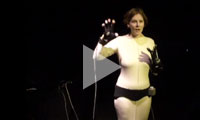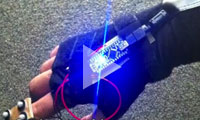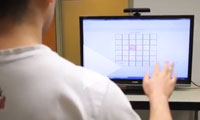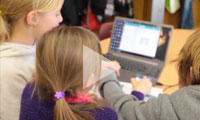


GRAND/CHI 2014
GRAND is a top sponsor of the 2014 ACM CHI Conference on Human Factors in Computing Systems (CHI 2014) - the premier international conference of Human-Computer Interaction. CHI 2014 focuses on diversity; from the broad range of backgrounds of its attendees (CHI 2013 broke all records, with 3442 attendees from 54 countries), to the diverse spectrum of communities and fields which the conference and its research impact. CHI 2014 will take place at the Metro Toronto Convention Centre in Toronto, Canada, a city itself known for its cultural diversity.
As in previous years, GRAND scholars from across Canada will converge at this premier event to present their research to the global Human-Computer Interaction community. Contributions include over 35 papers, as well as courses, research notes, and other presentations. A partial list of these activities is presented below.
NOTE: Be sure to check out MobileHCI 2014, also happening in Toronto, September 23-26, 2014.
CHI Courses
Designing for Seniors
|
Ronald Baecker, University of Toronto, GRAND Digital Media Pioneer Demographic trends and user diversity afford exciting design opportunities and challenges. We shall present two frameworks for envisioning solutions, and illustrate with landmark achievements, promising approaches, and open problems. Video: RI Seminar: Ronald Baecker: Technology in Support of Graceful |
VIDEO |
Introduction to Designing and Building Musical Interfaces
|
Michael Lyons (Ritsumeikan University, Kyoto, Japan), Axel Mulder (Infusion Systems Ltd., Montreal), Sidney Fels (University of British Columbia) This theory + hands-on course provides attendees with a practical overview of recent advances in musical interface research and a chance to prototype a new interface for musical expression. Video: CHI 14 Course Preview: Intro. to Designing and Building Musical Interfaces |
VIDEO |
Sampling & Synthesis: The Two Sides of Experience Sketching
|
William Buxton, Microsoft Research, GRAND Digital Media Pioneer We will explore two aspects of sketching experience and their relationship: constructivist approaches, where we synthesize the sketch, the other, where we take a page from Duchamp’s Readymades, and sample the world for (often) non-obvious technologies that serve as the sketch. eBay emerges as a potent a sketching tool as a pencil or foam core. Video: |
VIDEO
|
Speech-based Interaction: Myths, Challenges, and Opportunities
Gerald Penn, University of Toronto
Cosmin Munteanu, National Research Council Canada
Speech remains the "holy grail" of interaction, as this is the most natural form of communication that humans employ. Unfortunately, it is also one of the most difficult modalities to be understood by machines - despite, and perhaps, because it is the highest-bandwidth communication channel we possess. The goal of this course is to inform the MobileHCI community of the current state of speech and natural language research, to dispel some of the myths surrounding speech-based interaction.
Featured Papers
A Sustainable Design Fiction: Green Practices (TOCHI)
|
Ron Wakkary (Simon Fraser University), Audrey Desjardins (Simon Fraser University), Sabrina Hauser (Simon Fraser University), Leah A Maestri (Simon Fraser University) We argue that an approach informed by practice theory coupled with design fiction provides useful insights into the role of interaction design with respect to environmental sustainability. A practice-oriented approach can help interaction designers step away from models of individual behavior and studies of artifacts towards seeing sustainable behaviors as part of multidimensional and interrelated practices and practice elements. Video: A Sustainable Design FIction CHI 2014 |
VIDEO |
Exploring the Use of Hand-To-Face Input for Interacting with Head-Worn Displays
|
Marcos Serrano (University of Manitoba), Barrett M Ens (University of Manitoba), Pourang P Irani (University of Manitoba)
We propose the use of Hand-to-Face input, a method to interact with head-worn displays (HWDs) that involves contact with the face. We explore Hand-to-Face interaction to find suitable techniques for common mobile tasks. We evaluate this form of interaction with document navigation tasks and examine its social acceptability. In a first study, users identify the cheek and forehead as predominant areas for interaction and agree on gestures for tasks involving continuous input, such as document navigation. Video: Exploring Hand-To-Face Input for Interacting With Head-Worn Displays |
VIDEO |
Finder Highlights: Field Evaluation and Design of an Augmented File Browser (CHI Honourable Mention Award)
|
Stephen Fitchett (University of Canterbury, New Zealand), Andy Cockburn (University of Canterbury, New Zealand), Carl Gutwin (University of Saskatchewan)
Navigating to files through a hierarchy is often a slow, laborious, and repetitive task. Recent lab studies showed that file browser interface augmentations, such as Icon Highlights and Search Directed Navigation, have the potential to reduce file retrieval times. We describe the design, implementation, and longitudinal field study evaluation of Finder Highlights, a file browser plugin for the OS X 'Finder' that adds support for Icon Highlights and Search Directed Navigation. Video: Improving navigation-based file retrieval |
VIDEO |
Consumed Endurance: A Metric to Quantify Arm Fatigue of Mid-Air Interactions
|
Juan David Hincapié-Ramos (University of Manitoba), Xiang Guo (University of Manitoba), Paymahn Moghadasian (University of Manitoba), Pourang P Irani (University of Manitoba)
Mid-air interactions are prone to fatigue and lead to a feeling of heaviness in the upper limbs, a condition casually termed as the gorilla-arm effect. Designers have often associated limitations of their mid-air interactions with arm fatigue, but do not possess a quantitative method to assess and therefore mitigate it. We present a method to capture Consumed Endurance (CE) in a non-intrusive manner using an off-the-shelf camera-based skeleton tracking system, and demonstrate that CE correlates strongly with the Borg CR10 scale of perceived exertion. Video: Consumed Endurance: A Metric to Quantify Arm Fatigue of Mid-Air Interactions |
VIDEO |
Loopo: A Tangible Programming Game For Kids [PDF]
|
Carlo Ka-Ho Lai (School of Interactive Arts + Technology, Simon Fraser University), Yeseul Tracy Choi (SFU-SIAT), Brianna Jean Huxtable (SFU-SIAT), Jan Rainier Castro (SFU-SIAT), Andrew Hawryshkewich (SFU-SIAT), Carman Neustaedter (SFU-SIAT), Paulina Mun-Yee Lam (SFU-SIAT)
Loopo combines a specially designed tangible interface with a digital interface. The tangibility of Loopo encourages collaboration among the users and motivates them to learn together. To keep up with the increasingly earlier adoption of computer technology, Loopo’s goal is to teach children the fundamentals of computer programming in a fun, relatable, and interesting way, while nurturing collaboration through an easily approachable system. Video: Loopo: A Tangible Programming Game For Kids |
VIDEO |
Visualization of Personal History for Video Navigation
|
Abir Al-Hajri (University of British Columbia), Gregor Miller (UBC), Matthew Fong (UBC), Sidney S Fels (UBC)
We present an investigation of two different visualizations of video history: Video Timeline and Video Tiles. Video Timeline extends the commonly employed list-based visualization for navigation history by applying size to indicate heuristics and occupying the full screen with a two-sided timeline. Video Tiles visualizes history items in a grid-based layout by following pre-defined templates based on items' heuristics and ordering. Video: Visualization of Personal History for Video Navigation |
VIDEO |
Papers
Crossing-Based Selection with Direct Touch Input
Yuexing Luo, Daniel Vogel
The Usability of CommandMaps in Realistic Tasks
Joey Scarr, Andy Cockburn, Carl Gutwin, Andrea Bun,t Jared E Cechanowicz
Posting for Community and Culture: Considerations for the Design of Interactive Digital Bulletin Boards
Claude Fortin, Carman Neustaedter, Kate Hennessy
The Routines and Needs of Grandparents and Parents for Grandparent-Grandchild Conversations Over Distance
Azadeh Forghani, Carman Neustaedter
How Technology Supports Family Communication in Rural, Suburban, and Urban Kenya
Erick Oduor, Carman Neustaedter, Tejinder K Judge, Kate Hennessy, Carolyn Pang, Serena Hillman
WaaZam! Supporting Creative Play at a Distance in Customized Video Environments
Seth E Hunter, Pattie Maes, Anthony Tang, Kori M Inkpen, Susan M Hessey
Making Big Gestures: Effects of Gesture Size on Observability and Identification for Co-Located Group Awareness
Adrian Reetz, Carl Gutwin
“Kid-in-the-Loop” Content Control: A Collaborative and Education-oriented Content Filtering Approach
Yasmeen Hashish, Andrea Bunt, James E Young
LACES: Live Authoring through Compositing and Editing of Streaming Video
Dustin E Freeman, Stephanie Santosa, Fanny Chevalier, Ravin Balakrishnan, Karan Singh
Pupil Responses during Discrete Goal-directed Movements
Xianta Jiang, M Stella Atkins, Geoffrey C Tien, Roman Bednarik, Bin Zheng
Exploring Video Streaming in Public Settings: Shared Geocaching Over Distance Using Mobile Video Chat
Jason Procyk, Carman Neustaedter, Carolyn Pang, Anthony Tang, Tejinder K Judge
Highlighting Interventions and User Differences: Informing Adaptive Information Visualization Support
Giuseppe Carenini, Cristina Conati, Enamul Hoque, Ben Steichen, Dereck J Toker, James T Enns
Exertion in the Small: Improving Differentiation and Expressiveness in Sports Games with Physical Controls
Mike Sheinin, Carl Gutwin
The Effectiveness (or Lack Thereof) of Aim-Assist Techniques in First-Person Shooter Games
Rodrigo Vicencio-Moreira, Regan L Mandryk, Carl Gutwin, Scott Bateman
Faster Command Selection on Tablets with FastTap
Carl Gutwin, Andy Cockbur,n Joey Scarr, Sylvain Malacria, Scott C Olson
Interface Design for Older Adults with Varying Cultural Attitudes toward Uncertainty
Shathel Haddad, Joanna McGrenere, Claudia Jacova
Effects of Balancing for Physical Abilities on Player Performance, Experience and Self-Esteem in Exergames
Kathrin M Gerling, Matthew Miller, Regan L Mandryk, Max V Birk, Jan D Smeddinck
The Effects of Embodied Persuasive Games on Player Attitudes Toward People Using Wheelchairs
Kathrin M Gerling, Regan L Mandryk, Max V Bir,k Matthew Miller, Rita Orji
TaggedComments: Promoting and Integrating User Comments in Online Application Tutorials
Andrea Bunt, Patrick Dubois, Ben Lafreniere, Michael A Terry, David T Cormack
The Personal Cockpit: A Spatial Interface for Effective Task Switching on Head-Worn Displays
Barrett M Ens, Rory Finnegan, Pourang P Irani
Other Presentations/Submissions
Design Tactics for Authentic Interactive Fiction: Insights from Alternate Reality Game Designer
Elizabeth M Bonsignore, Vicki Moulder, Carman Neustaedter, Derek L Hansen, kari kraus, Allison Druin
OneSpace: Shared Visual Scenes for Active Freeplay
Maayan Cohen, Kody R Dillman, Haley MacLeod, Seth Hunter, Anthony Tang
HCI Interventions with Nonprofit Organizations: Tactics for Effective Collaboration
Vicki Moulder, Lorna Boschman, Ron Wakkary, William Odom, Stacey Kuznetsov
Mining Online Software Tutorials: Challenges and Open Problems (altchi)
Adam Fourney, Michael Terry
Games and Entertainment Community SIG: Reaching beyond CHI (SIG)
Lennart Nacke, Pejman Mirza-Babaei, Magy Seif El-Nasr, Heather Desurvire, Regina Bernhaupt
Interactions Magazine (SIG)
Ron Wakkary, Erik Stolterman
 | GRAND Events |
 | GRAND Sponsored |
 | GRAND Participants |
 | Community Events |









